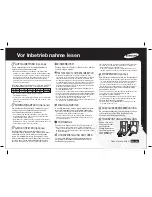
6712SR Refrigerated Sampler
Section 8 Maintenance
8-2
Make sure the two pump drain holes (located on the bottom
right-hand side of the pump, beneath the pump band) are open
and free of debris or buildup.
8.2.3 Sample Bottles
The sample bottles have a wide mouth to facilitate cleaning.
Wash them with a brush and soapy water, or use a dishwasher.
You can autoclave the glass bottles.
8.2.4 Suction Line, Pump
Tube, and Discharge
Tube
Clean the suction line, pump tube, and discharge tube by placing
the end of the suction line in a cleaning solution and pumping it
through the delivery system. Rinse with clean water. If these
items are severely contaminated, discard them. For critical sam-
pling applications, refer to Section 8.3, Cleaning Protocols for
Priority Pollutants.
8.2.5 Strainer
Clean the strainer with a brush and soapy water.
8.2.6 Air Filter
The air filter prevents dust, lint, and other debris from circu-
lating around the cooling system. Clean the filter about every 3
months; more frequently under severe operating conditions.
To remove the filter:
1. Disconnect power from the refrigerator.
2. Remove the screws securing the refrigerator’s grille. (See
Appendix D Replacement Parts.)
3. Remove the grille and filter.
4. Steam clean the filter or wash it in hot, soapy water. After
washing, treat the filter with a standard filter coat.
8.2.7 Condenser
Clean the condenser and surrounding areas annually; more fre-
quently under severe operating conditions.
1. Disconnect power from the refrigerator.
2. Remove refrigerator’s back panel. (See Appendix D,
Replacement Parts).
3. Vacuum the fan, compressor, and surrounding areas.
4. Check the fan for freedom of movement. If the fan and fan
motor do not rotate freely, replace the motor. (You cannot
oil the sealed fan motor bearings.)
5. Remove the front grille and filter. Vacuum the condenser
coil and surrounding areas.
6. Clean the filter before replacing it.
7. Replace the back panel and front grille.
8.3 Cleaning Protocols for
Priority Pollutants
Clean sampling equipment is essential for valid laboratory
analysis. Teledyne Isco recommends that you develop cleaning
protocols in consultation with a laboratory analyst when
designing the monitoring program. For example, to clean sample
bottles, suction line, and pump tubes, Lair (1974) suggests these
protocols used by USEPA Region IV Surveillance and Analysis
field personnel engaged in NPDES compliance monitoring. The
Summary of Contents for 6712SR
Page 2: ......
Page 4: ......
Page 14: ...6712SR Refrigerated Sampler Table of Contents xii ...
Page 28: ...6712SR Refrigerated Sampler Section 1 Introduction 1 14 ...
Page 42: ...6712SR Refrigerated Sampler Section 2 Installation Preparation 2 14 ...
Page 54: ...6712SR Refrigerated Sampler Section 3 Getting Started 3 12 ...
Page 140: ...6712SR Refrigerated Sampler Section 6 SDI 12 Sondes 6 8 ...
Page 188: ...6712SR Refrigerated Sampler Appendix A Menu Flowcharts A 24 ...
Page 196: ...6712SR Refrigerated Sampler Appendix B Material Safety Data Sheets B 8 ...
Page 206: ...6712SR Refrigerated Sampler Appendix D Replacement Parts D 2 ...
Page 207: ...6712SR Refrigerated Sampler Appendix D Replacement Parts D 3 ...
Page 208: ...6712SR Refrigerated Sampler Appendix D Replacement Parts D 4 Locknut 10 32 Screw 10 32 x 3 4 ...
Page 209: ...6712SR Refrigerated Sampler Appendix D Replacement Parts D 5 ...
Page 210: ...6712SR Refrigerated Sampler Appendix D Replacement Parts D 6 ...
Page 211: ...6712SR Refrigerated Sampler Appendix D Replacement Parts D 7 ...
Page 212: ...6712SR Refrigerated Sampler Appendix D Replacement Parts D 8 ...
Page 218: ...6712SR Refrigerated Sampler Appendix E Accessories List E 6 ...
Page 222: ...6712SR Refrigerated Sampler Index Index 4 ...
Page 224: ......
















































